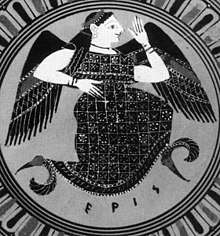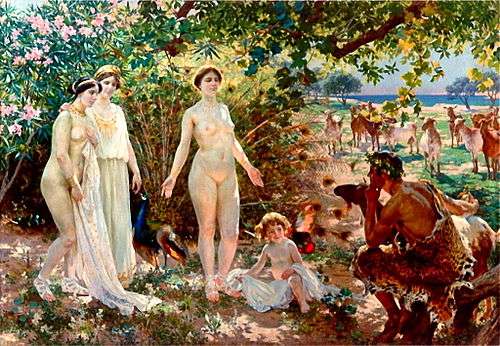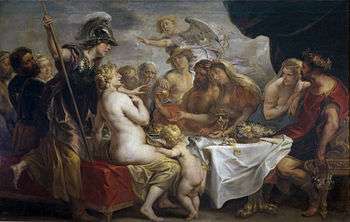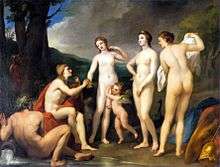Eris (mythology)
Eris (/ˈɪərɪs, ˈɛrɪs/; Greek: Ἔρις Éris, "Strife") is the Greek goddess of strife and discord. Her Roman equivalent is Discordia, which means "discord". Eris's Greek opposite is Harmonia, whose Roman counterpart is Concordia.[1] Homer equated her with the war-goddess Enyo, whose Roman counterpart is Bellona. The dwarf planet Eris is named after the goddess.
| Eris | |
|---|---|
Goddess of strife and discord | |
 Eris on an Attic plate, ca. 575–525 BC | |
| Symbol | Golden Apple of Discord |
| Personal information | |
| Parents | Nyx (alone) or with Erebus, or Zeus and Hera |
| Siblings | Aeacus, Angelos, Aphrodite, Apollo, Ares, Artemis, Athena, Dionysus, Eileithyia, Enyo, Ersa, Hebe, Helen of Troy, Heracles, Hermes, Minos, Pandia, Persephone, Perseus, Rhadamanthus, the Graces, the Horae, the Litae, the Muses, the Moirai, or Thanatos, Hypnos, the Keres, Hemera, Aether, Moros, Apate, Furies, Oneiroi, Nemesis, Geras, Eleos, Philotes, Oizys, Momus. |
| Children | Dysnomia, Ponos, Atë, Lethe, Limos, Algos, Hysminai, Makhai, Phonoi, Androktasiai, Neikea, Amphilogiai, Horkos |
| Roman equivalent | Discordia |
She had no temples in ancient Greece (Concordia had several in Italy), and functions essentially as a personification, as which she appears in Homer and many later works.
Etymology
Eris is of uncertain etymology; connections with the verb ὀρίνειν orinein, "to raise, stir, excite," and the proper name Ἐρινύες Erinyes have been suggested. R. S. P. Beekes rejects these derivations and suggested a Pre-Greek origin.[2]
Characteristics in Greek mythology



In Hesiod's Works and Days 11–24, two different goddesses named Eris are distinguished:
So, after all, there was not one kind of Strife alone, but all over the earth there are two. As for the one, a man would praise her when he came to understand her; but the other is blameworthy: and they are wholly different in nature. For one fosters evil war and battle, being cruel: her no man loves; but perforce, through the will of the deathless gods, men pay harsh Strife her honour due.
But the other is the elder daughter of dark Night (Nyx), and the son of Cronus [i.e. Zeus] who sits above and dwells in the aether, set her in the roots of the earth: and she is far kinder to men. She stirs up even the shiftless to toil; for a man grows eager to work when he considers his neighbour, a rich man who hastens to plough and plant and put his house in good order; and neighbour vies with his neighbour as he hurries after wealth. This Strife is wholesome for men. And potter is angry with potter, and craftsman with craftsman and beggar is jealous of beggar, and minstrel of minstrel.
In Hesiod's Theogony (226–232), Strife, the daughter of Night, is less kindly spoken of as she brings forth other personifications as her children:
- And hateful Eris bore painful Ponos ("Hardship"),
- Lethe ("Forgetfulness") and Limos ("Starvation") and the tearful Algea ("Pains"),
- Hysminai ("Battles"), Makhai ("Wars"), Phonoi ("Murders"), and Androktasiai ("Manslaughters");
- Neikea ("Quarrels"), Pseudea ("Lies"), Logoi ("Stories"), Amphillogiai ("Disputes")
- Dysnomia ("Anarchy") and Ate ("Ruin"), near one another,
- and Horkos ("Oath"), who most afflicts men on earth,
- Then willing swears a false oath.[3]
The other Strife is presumably she who appears in Homer's Iliad Book IV; equated with Enyo as sister of Ares and so presumably daughter of Zeus and Hera:
Strife whose wrath is relentless, she is the sister and companion of murderous Ares, she who is only a little thing at the first, but thereafter grows until she strides on the earth with her head striking heaven. She then hurled down bitterness equally between both sides as she walked through the onslaught making men's pain heavier. She also has a son whom she named Strife.
Enyo is mentioned in Book 5, and Zeus sends Strife to rouse the Achaeans in Book 11, of the same work.
The most famous tale of Eris recounts her initiating the Trojan War by causing the Judgement of Paris. The goddesses Hera, Athena and Aphrodite had been invited along with the rest of Olympus to the forced wedding of Peleus and Thetis, who would become the parents of Achilles, but Eris had been snubbed because of her troublemaking inclinations.
She therefore (as mentioned at the Kypria according to Proclus as part of a plan hatched by Zeus and Themis) tossed into the party the Apple of Discord, a golden apple inscribed Ancient Greek: τῇ καλλίστῃ, romanized: tē(i) kallistē(i) – "For the most beautiful one", or "To the Fairest One" – provoking the goddesses to begin quarreling about the appropriate recipient. The hapless Paris, Prince of Troy, was appointed to select the fairest by Zeus. The goddesses stripped naked to try to win Paris's decision, and also attempted to bribe him. Hera offered political power; Athena promised infinite wisdom; and Aphrodite tempted him with the most beautiful woman in the world: Helen, wife of Menelaus of Sparta. While Greek culture placed a greater emphasis on prowess and power, Paris chose to award the apple to Aphrodite, thereby dooming his city, which was destroyed in the war that ensued.
In Nonnus's Dionysiaca, 2.356, when Typhon prepares to battle with Zeus:
Eris ("Strife") was Typhon's escort in the melée, Nike ("Victory") led Zeus to battle.
Another story of Eris includes Hera, and the love of Polytekhnos and Aedon. They claimed to love each other more than Hera and Zeus were in love. This angered Hera, so she sent Eris to wreak discord upon them. Polytekhnos was finishing off a chariot board, and Aedon a web she had been weaving. Eris said to them, "Whosoever finishes thine task last shall have to present the other with a female servant!" Aedon won. But Polytekhnos was not happy by his defeat, so he came to Khelidon, Aedon's sister, and raped her. He then disguised her as a slave, presenting her to Aedon. When Aedon discovered this was indeed her sister, she chopped up Polytekhnos's son and fed him to Polytekhnos. The gods were not pleased, so they turned them all into birds.
Cultural influences

Discordianism
Eris has been adopted as the patron deity of the modern Discordian religion, which was begun in the late 1950s by Gregory Hill and Kerry Wendell Thornley under the pen names of "Malaclypse the Younger" and "Omar Khayyam Ravenhurst". The Discordian version of Eris is considerably lighter in comparison to the rather malevolent Graeco-Roman original, wherein she is depicted as a positive (albeit mischievous) force of chaotic creation.
A quote from the Principia Discordia, the first holy book of Discordianism, attempts to clear up the matter:
One day Mal-2 consulted his Pineal Gland and asked Eris if She really created all of those terrible things. She told him that She had always liked the Old Greeks, but that they cannot be trusted with historic matters. "They were," She added, "victims of indigestion, you know." Suffice it to say that Eris is not hateful or malicious. But she is mischievous, and does get a little bitchy at times.[4]
The story of Eris being snubbed and indirectly starting the Trojan War is recorded in the Principia, and is referred to as the Original Snub. The Principia Discordia states that her parents may be as described in Greek legend, or that she may be the daughter of Void. She is the Goddess of Disorder and Being, whereas her sister Aneris (called the equivalent of Harmonia by the Mythics of Harmonia) is the goddess of Order and Non-Being. Their brother is Spirituality.[5]
Discordian Eris is looked upon as a foil to the preoccupation of western philosophy in attempting find order in the chaos of reality, in prescribing order to be synonymous with truth. Discordian Eris teaches us that the only truth is chaos, and that order and disorder are simply temporary filters applied to the lenses we view the chaos through. This is known as the Aneristic Illusion.[6]
In this telling, Eris becomes something of a patron saint of chaotic creation:
I am chaos. I am the substance from which your artists and scientists build rhythms. I am the spirit with which your children and clowns laugh in happy anarchy. I am chaos. I am alive, and I tell you that you are free.[7]
The concept of Eris as developed by the Principia Discordia is used and expanded upon in the science fiction work The Illuminatus! Trilogy by Robert Shea and Robert Anton Wilson (in which characters from Principia Discordia appear). In this work, Eris is a major character.[8]
Other
The classic fairy tale Sleeping Beauty is partly inspired by Eris's role in the wedding of Peleus and Thetis. Like Eris, a malevolent fairy curses a princess after not being invited to the princess's christening.[9][10]
Notes
- Ruoff, s.v. Eris, p. 329.
- R. S. P. Beekes, Etymological Dictionary of Greek, Brill, 2009, p. 459).
- Caldwell, p. 42 lines 226-232, with the meanings of the names (in parentheses), as given by Caldwell, p. 40 on lines 212–232.
- "The Principia Discordia". Ology.org. 1997-04-21. Retrieved 2012-06-14.
- "Page 57". Principia Discordia. Retrieved 2012-06-14.
- "Principia Discordia - Page 49". www.principiadiscordia.com. Retrieved 2017-09-22.
- "The Principia Discordia". Ology.org. 1997-04-21. Retrieved 2012-06-14.
- "Robert Anton Wilson: Searching For Cosmic Intelligence" by Jeffrey Elliot Archived June 14, 2006, at the Wayback Machine Interview discussing novel (URL accessed 21 February 2006)
- H. J. Rose (2006). A Handbook of Greek Mythology, Including Its Extension to Rome. Kessinger Publishing. ISBN 978-1-4286-4307-9. Retrieved 2007-11-06.
- Maria Tatar (Ed.) (2002). The Annotated Classic Fairy Tales. W. W. Norton & Company. ISBN 978-0-393-05163-6. Retrieved 2007-11-06.CS1 maint: extra text: authors list (link)
References
- Caldwell, Richard, Hesiod's Theogony, Focus Publishing/R. Pullins Company (June 1, 1987). ISBN 978-0-941051-00-2.
External links
| Wikimedia Commons has media related to Eris (mythology). |
- Hesiod’s Works And Days
- Hesiod’s Theogony
- Homer’s Iliad
- Homer's Iliad at Gutenberg (there are many different translations at Gutenberg)
